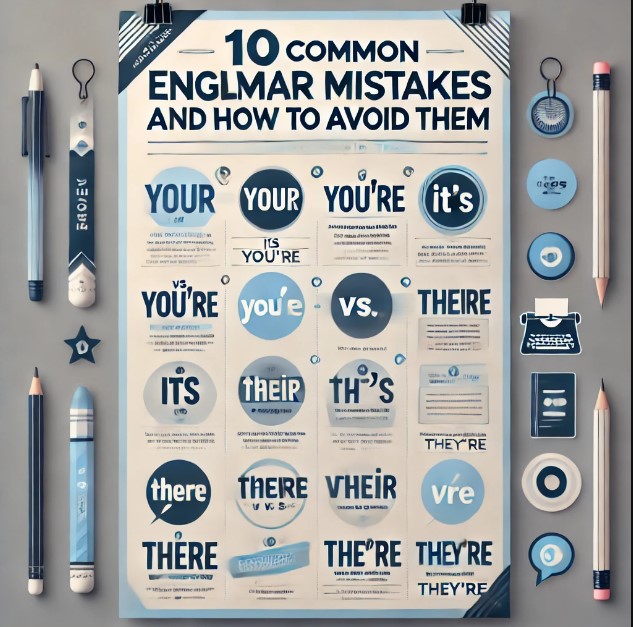10 Common English Grammar Mistakes and How to Avoid Them
Introduction
Do you ever feel unsure about your grammar when writing an email or report? You’re not alone! English grammar, with its quirky rules and exceptions, can challenge even native speakers. However, understanding the most common grammar mistakes can drastically improve your writing skills and boost your confidence.
This guide explores 10 common English grammar mistakes and provides actionable advice to help you avoid them. Whether you’re a beginner or a professional, these tips will make your communication more effective and error-free.
Common Grammar Mistakes and How to Fix Them
1. Misusing “Your” and “You’re”
This classic mistake trips up even seasoned writers.
- Your is a possessive pronoun (e.g., “Your car is parked outside”).
- You’re is a contraction for “you are” (e.g., “You’re going to the meeting, right?”).
Example Mistake:
- Incorrect: Your welcome to join us.
- Correct: You’re welcome to join us.
How to Avoid:
When proofreading, substitute “you are” to check if the sentence still makes sense. If it doesn’t, “your” is the correct choice.
2. Confusing “Their,” “There,” and “They’re”
Homophones like these cause endless confusion:
- Their indicates possession (e.g., “Their ideas are innovative”).
- There refers to a place (e.g., “The conference is over there”).
- They’re is short for “they are” (e.g., “They’re excited about the project”).
Example Mistake:
- Incorrect: Their going to submit the report soon.
- Correct: They’re going to submit the report soon.
How to Avoid:
Practice recognizing the context. Is it possession, location, or a contraction? Use the appropriate term accordingly.
3. Subject-Verb Agreement Errors
This mistake happens when the subject and verb don’t align in number (singular or plural).
Example Mistake:
- Incorrect: The list of tasks are overwhelming.
- Correct: The list of tasks is overwhelming.
How to Avoid:
Identify the subject and determine if it’s singular or plural. Adjust the verb to match.
4. Misplacing Apostrophes
Apostrophes are used for possession or contractions but not for making plurals.
Example Mistake:
- Incorrect: The Smith’s are coming to dinner.
- Correct: The Smiths are coming to dinner.
How to Avoid:
For possession, add an apostrophe (e.g., “The Smiths’ car”). For plurals, avoid apostrophes.
5. Mixing Up “Its” and “It’s”
The difference between “its” and “it’s” confounds many writers.
- Its is a possessive pronoun (e.g., “The dog wagged its tail”).
- It’s is a contraction for “it is” or “it has” (e.g., “It’s been a productive day”).
Example Mistake:
- Incorrect: The machine needs to finish it’s cycle.
- Correct: The machine needs to finish its cycle.
How to Avoid:
Expand the contraction to “it is” or “it has” during proofreading. If it works, “it’s” is correct.
Sentence Structure Mistakes
6. Fragmented Sentences
Fragments lack a subject, verb, or complete thought.
Example Mistake:
- Incorrect: When we arrived at the event.
- Correct: When we arrived at the event, the program had already started.
How to Avoid:
Ensure every sentence has a subject and a verb. Read your sentences aloud to check for completeness.
7. Run-On Sentences
Run-on sentences occur when independent clauses are improperly joined.
Example Mistake:
- Incorrect: I love coffee it keeps me awake.
- Correct: I love coffee because it keeps me awake.
How to Avoid:
Break long sentences with proper punctuation or conjunctions. Use tools like semicolons for clarity.
8. Dangling Modifiers
Modifiers should clearly refer to the subject they describe.
Example Mistake:
- Incorrect: Running down the street, the ball slipped out of her hand.
- Correct: Running down the street, she dropped the ball.
How to Avoid:
Ensure modifiers are placed next to the subject they describe.
Word Choice Errors
9. Confusing Homophones
Homophones sound the same but have different meanings, e.g., “affect” (verb) vs. “effect” (noun).
Example Mistake:
- Incorrect: The weather will effect our plans.
- Correct: The weather will affect our plans.
How to Avoid:
Learn common homophones and their meanings to minimize confusion.
10. Overusing Double Negatives
Double negatives create unnecessary confusion.
Example Mistake:
- Incorrect: I don’t need no help.
- Correct: I don’t need any help.
How to Avoid:
Stick to single negatives for clearer communication.
Advanced Tips for Flawless Grammar
- Use Grammar Checkers: Tools like Grammarly and ProWritingAid can spot errors quickly.
- Read Aloud: Hearing your sentences helps catch awkward phrasing.
- Practice Regularly: Write daily to reinforce correct grammar usage.
- Learn the Rules: Invest time in understanding fundamental grammar rules.
- Seek Feedback: Have someone else review your work for errors.
Conclusion
Good grammar enhances clarity and professionalism in your writing. By understanding and avoiding these common mistakes, you’ll communicate more effectively, whether in casual conversations or professional settings. Remember, practice makes perfect, and the more you write and review, the better your grammar skills will become.
FAQs
1. How can I improve my grammar?
Start with the basics, practice consistently, and use grammar tools for guidance.
2. What are common tools for checking grammar?
Grammarly, Hemingway Editor, and ProWritingAid are excellent options.
3. Why do homophones confuse writers?
Homophones sound the same but have different meanings, making them tricky.
4. Can grammar errors impact my career?
Yes, poor grammar can harm your professional credibility and communication.
5. Are there exceptions to grammar rules?
Yes, English grammar has many exceptions, but learning the basics helps.

